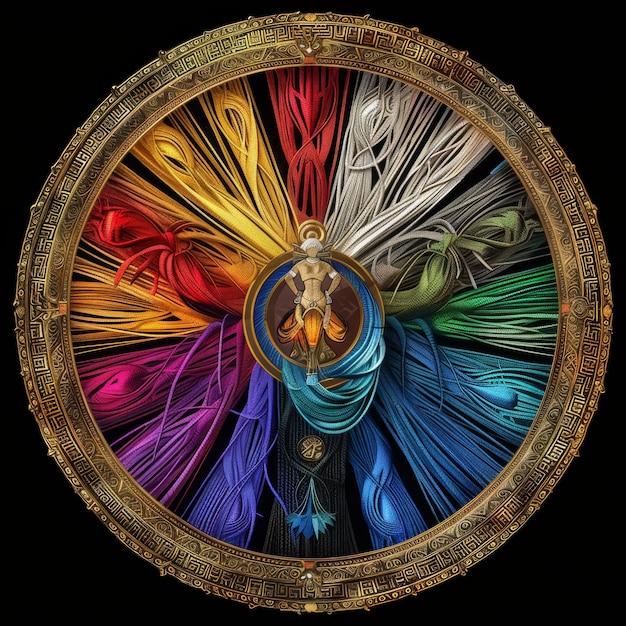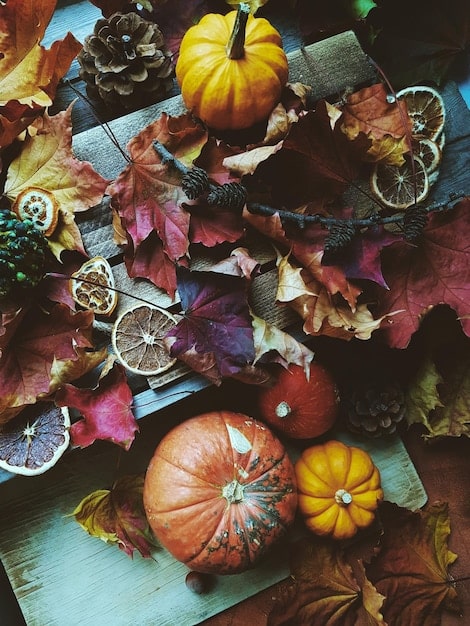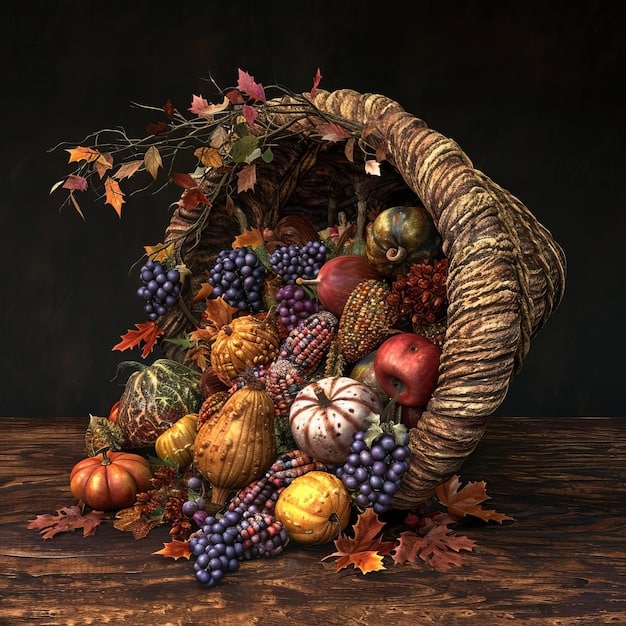Celebrating the Sabbats: Honoring the Wheel of the Year

Celebrating the Sabbats: Honoring the Wheel of the Year and Seasonal Energies involves recognizing and participating in eight festivals that mark significant points in the solar cycle, deeply connected to nature’s rhythms and agricultural transitions.
Celebrating the turning of the year offers a profound way to connect with nature’s cycles and deepen your spiritual practice. Interested in learning more about the eight Sabbats and their unique energies?
The Wheel of the Year, central to many Wiccan and Pagan traditions, guides us through a cycle of seasonal celebrations known as Sabbats. Celebrating the Sabbats: Honoring the Wheel of the Year and Seasonal Energies is more than just marking dates on a calendar; it’s about understanding and participating in the energetic shifts happening around us. These festivals, rooted in agricultural traditions, offer a pathway to align with the earth’s rhythms and harness the potent energies of each season.
Understanding the Wheel of the Year
The Wheel of the Year is a Wiccan and Pagan concept representing the annual cycle of seasons. Each turn brings changes to nature, and the Sabbats represent key points in this cycle. Let’s delve deeper into what makes up this vital spiritual compass.
The Significance of Solar Events
The Sabbats are astronomically aligned with solstices and equinoxes, as well as the midpoints between them. These events mark the sun’s journey and its influence on the earth.
- Solstices: These mark the longest and shortest days of the year, representing peak moments of solar energy (summer) and its lowest ebb (winter).
- Equinoxes: Equinoxes occur twice a year when day and night are of equal length, representing balance and transition.
- Cross-Quarter Days: These fall midway between the solstices and equinoxes, marking significant shifts in the agricultural cycle.
With the passing of these solar celebrations we can understand the importance of celebrating the Sabbats: Honoring the Wheel of the Year and Seasonal Energies.
Understanding the Wheel of the Year allows us to align our personal rhythms with the natural world, enhancing our spiritual connection to the earth and its cycles.
The Eight Sabbats: A Seasonal Guide
Each Sabbat has its own unique energy, traditions, and significance. Celebrating the Sabbats: Honoring the Wheel of the Year and Seasonal Energies involves understanding what makes each celebration special. Here’s a look at each one:

Yule (Winter Solstice)
Yule marks the shortest day of the year and the rebirth of the Sun. It’s a time for celebrating light in the darkness and anticipating the return of longer days.
- Traditions: Burning the Yule log, decorating evergreen trees, and exchanging gifts.
- Energy: Hope, renewal, and the promise of brighter days ahead.
Imbolc (February 2nd)
Imbolc celebrates the first signs of spring and the stirring of new life. It’s a time to honor the Celtic goddess Brigid and focus on purification and growth.
- Traditions: Candlemas rituals, purifying the home, and planting seeds.
- Energy: New beginnings, inspiration, and the clearing away of the old.
Ostara (Spring Equinox)
Ostara marks the arrival of spring and the balance between day and night. It’s a time for celebrating fertility, growth, and new beginnings.
- Traditions: Decorating eggs, planting seeds, and celebrating the balance of light and dark.
- Energy: Fertility, growth, and new possibilities.
Beltane (May 1st)
Beltane celebrates the peak of spring and the union of the God and Goddess. It’s a time for celebrating passion, fertility, and the vibrant energy of life.
- Traditions: Maypole dances, bonfires, and celebrating love and fertility.
- Energy: Passion, fertility, and abundance.
Litha (Summer Solstice)
Litha marks the longest day of the year and the peak of the Sun’s power. It’s a time for celebrating abundance, joy, and the fullness of life.
- Traditions: Bonfires, outdoor feasts, and celebrating the power of the Sun.
- Energy: Abundance, joy, and vitality.
Lammas/Lughnasadh (August 1st)
Lammas marks the first harvest and the beginning of the waning of the Sun. It’s a time for giving thanks for the abundance of the earth and preparing for the coming winter.
- Traditions: Baking bread, harvesting grains, and giving thanks for the earth’s bounty.
- Energy: Gratitude, abundance, and preparation.
Mabon (Autumn Equinox)
Mabon marks the arrival of autumn and the balance between day and night. It’s a time for celebrating the harvest, giving thanks, and preparing for the coming winter.
- Traditions: Gathering harvest foods, decorating with autumn leaves, and celebrating balance and gratitude.
- Energy: Gratitude, balance, and preparation for the darker months.
Samhain (October 31st)
Samhain marks the end of the harvest season and the beginning of winter. It’s a time for honoring ancestors, reflecting on the past year, and connecting with the spirit world.
- Traditions: Honoring ancestors, divination, and celebrating the cycle of life and death.
- Energy: Transformation, reflection, and connection with the spirit world.
Understanding each Sabbat and its unique energy allows for a well-rounded celebration of the Wheel of the Year. It deepens your connection with nature and the spiritual significance of each seasonal transition.
Rituals and Practices for Celebrating the Sabbats
Celebrating the Sabbats: Honoring the Wheel of the Year and Seasonal Energies can involve a variety of rituals and practices that resonate with the themes of each season. Connecting through these rituals makes the celebrations more memorable and meaningful.
Creating an Altar
Setting up an altar that reflects the current Sabbat is a powerful way to honor the season. Use seasonal colors, symbols, and natural objects to create a focal point for your celebrations.
Incorporating Seasonal Foods
Food has always been an integral part of seasonal celebrations. Preparing and sharing dishes made with seasonal ingredients can deepen your connection to the earth’s bounty.
Nature Walks and Outdoor Activities
Spending time in nature is a wonderful way to connect with the energies of each Sabbat. Take a walk in the woods, visit a local farm, or simply sit in your garden and observe the changes happening around you.
By adapting rituals and practices to the specific energies of each Sabbat, you can enrich your spiritual life and deepen your connection with the natural world.

The Benefits of Honoring Seasonal Energies
Aligning with the Wheel of the Year provides numerous benefits, enhancing both your spiritual and personal life. Celebrating the Sabbats: Honoring the Wheel of the Year and Seasonal Energies offers a path to deeper understanding and personal growth.
Enhanced Connection with Nature
By paying attention to the changing seasons and participating in Sabbat celebrations, you develop a stronger connection with the natural world. This connection can bring a sense of peace, grounding, and belonging.
Personal Growth and Transformation
Each Sabbat offers an opportunity for self-reflection and personal growth. By aligning your intentions with the energies of the season, you can facilitate positive changes in your life.
Strengthened Spiritual Practice
Celebrating the Sabbats provides a framework for a regular spiritual practice. It encourages you to connect with deities, ancestors, and the spiritual realm in a meaningful way.
From deepening your connection with nature to facilitating personal growth, the benefits of recognizing and honoring the seasonal energies are vast and transformative.
Integrating the Sabbats into Modern Life
While the Sabbats have ancient roots, they can be seamlessly integrated into modern life. Discovering meaningful ways of celebrating the Sabbats: Honoring the Wheel of the Year and Seasonal Energies enriches daily routines.
Balancing Tradition and Modernity
Adapt Sabbat traditions to fit your lifestyle and beliefs. There’s no right or wrong way to celebrate—focus on what feels authentic and meaningful to you.
Finding Community
Connect with others who share your interest in the Wheel of the Year. Join a local Wiccan or Pagan group, attend online workshops, or participate in online forums to share experiences and learn from others.
Mindful Living
Use the Sabbats as reminders to live more mindfully throughout the year. Pay attention to the changing seasons, embrace gratitude, and cultivate a sense of connection with the earth and all living beings.
By finding creative and meaningful ways to integrate the Sabbats into modern life, you can bring the wisdom and magic of the Wheel of the Year into your everyday experience.
| Key Moment | Brief Description |
|---|---|
| ☀️ Solstices | Longest/shortest days; peak energy. |
| 🌱 Equinoxes | Equal day/night; balance, transition. |
| 🍂 Samhain | Honoring ancestors; end of harvest. |
| 🔥 Beltane | Peak spring; celebrating fertility. |
Frequently Asked Questions
The Sabbats are eight festivals that mark key points in the solar year, representing the changing seasons and their associated energies. They are central to many Wiccan and Pagan traditions.
Start by learning about each Sabbat and its traditions. Create a simple altar, incorporate seasonal foods, and spend time in nature. Focus on practices that feel authentic to you.
It helps you connect with nature’s cycles, deepen your spiritual practice, and facilitate personal growth. The Sabbats provide a framework for mindful living and gratitude.
No, you don’t need to be Wiccan. The Sabbats are based on natural cycles and agricultural traditions that can be celebrated by anyone who feels a connection to the earth.
Symbols vary by Sabbat but often include seasonal foods, colors, and natural objects. For example, eggs and flowers represent Ostara, while pumpkins and autumn leaves signify Samhain.
Conclusion
Celebrating the Sabbats: Honoring the Wheel of the Year and Seasonal Energies offers a rich and meaningful way to connect with nature, deepen your spiritual practice, and enhance your personal growth. By understanding and participating in these seasonal celebrations, you can align your life with the earth’s rhythms and experience the magic of the Wheel of the Year.





